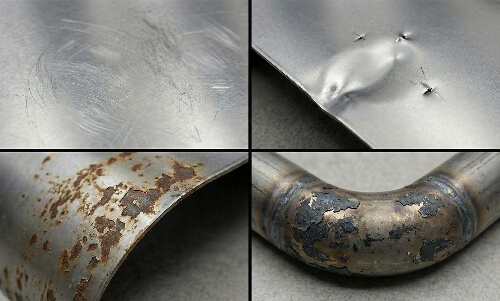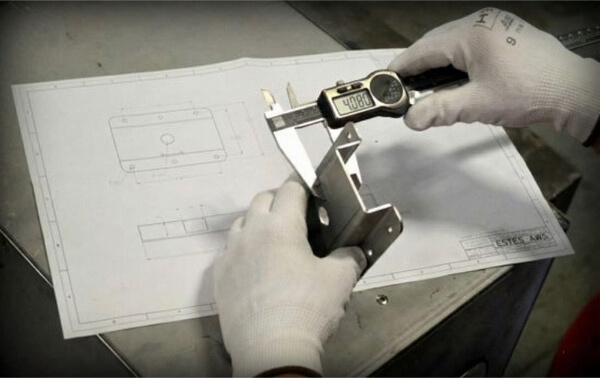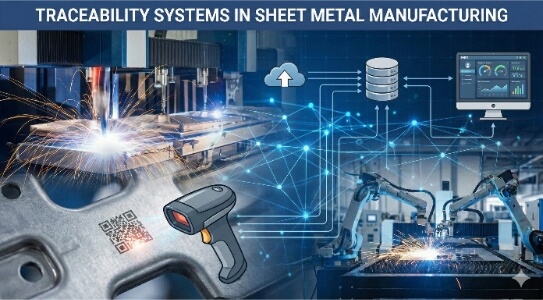يستخدم العديد من المهنيين مصطلحي "التصنيع" و"التصنيع" دون إدراك أن لهما معنيين مختلفين. وقد يؤدي ذلك إلى إرباكهم، خاصةً عند اختيار الموردين أو التخطيط للإنتاج. إذا لم يكن المصطلحان غير واضحين، فمن السهل اختيار العملية الخاطئة، مما يؤدي إلى إهدار الوقت والمال والجهد. يوضح هذا المنشور الفرق بعبارات بسيطة حتى تتمكن من اتخاذ قرارات أفضل وتجنب المشاكل.
التصنيع هو عملية إنشاء أجزاء أو هياكل من المواد الخام باستخدام طرق القطع والثني واللحام. التصنيع هو العملية الأوسع نطاقاً لتحويل المواد الخام إلى سلع تامة الصنع. وهو يشمل التصنيع ولكنه يشمل أيضًا التجميع والتشغيل الآلي والتعبئة والتغليف وغير ذلك. التصنيع هو النظام بأكمله، والتصنيع هو خطوة واحدة داخله.
غالبًا ما يتداخل التصنيع والتصنيع. لكنهما ليسا متماثلين. دعونا نلقي نظرة فاحصة على كيفية عملهما وأين ينفصلان.
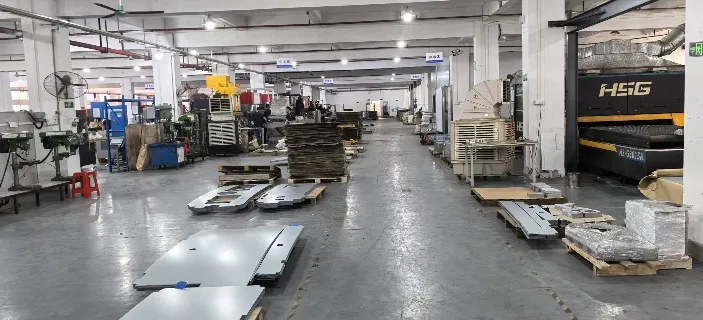
ما هو التصنيع؟
التصنيع يعني بناء الأجزاء من المواد الخام. وهو يتضمن قطع أو ثني أو لحام أو تجميع المعادن أو المواد الأخرى. والكلمة مشتقة من الكلمة اللاتينية manufactate، وتعني "صنع".
التصنيع هو المعيار في صناعات الإنشاءات والسيارات والفضاء والطيران وتشغيل المعادن. وهي تصنع أجزاء أو أدوات أو هياكل مخصصة، عادةً من صفائح أو أنابيب أو قضبان معدنية.
ما هو التصنيع؟
التصنيع هو العملية الكاملة لتحويل المواد الخام إلى منتجات تامة الصنع. وتشمل العديد من الخطوات، مثل التصنيع الآلي والصب والقولبة والتجميع والاختبار والتعبئة والتغليف.
يستخدم التصنيع في الإنتاج الضخم. وتستخدمه المصانع لصناعة المنتجات على نطاق واسع - كل شيء من الإلكترونيات والآلات إلى الملابس والأجهزة المنزلية.
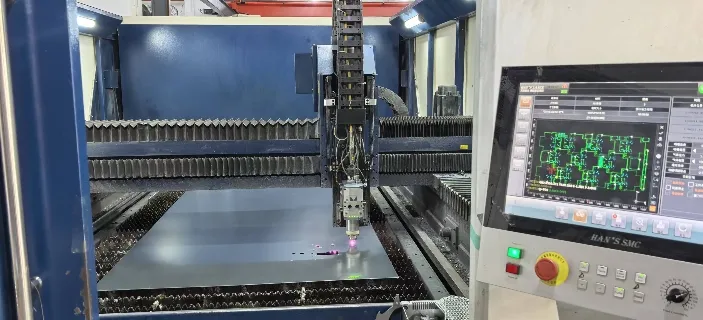
الاختلافات الرئيسية بين التصنيع والتصنيع
قد يبدو المصطلحان متقاربان ولكنهما يختلفان في الغرض والحجم والأساليب. دعونا نلقي نظرة على كيفية المقارنة بينهما عبر عدة عوامل رئيسية.
نطاق العمل
يركز التصنيع على تشكيل وربط المواد لصنع الأجزاء أو الهياكل. أما التصنيع فيغطي السلسلة بأكملها - من المواد الخام إلى المنتجات المعبأة الجاهزة للسوق.
أنواع المنتجات المعنية
ينتج التصنيع عادةً مكونات أو إطارات أو هياكل، والتي قد تكون جزءًا من منتج أكبر. أما التصنيع فينتج السلع النهائية، مثل الآلات أو الأدوات أو المنتجات الاستهلاكية.
المواد المستخدمة
يستخدم التصنيع بشكل أساسي المعادن والبلاستيك والمواد المركبة. ويستخدم التصنيع هذه المواد، ولكنه يشمل أيضاً المنسوجات والمواد الكيميائية والزجاج وغيرها.
حجم الإنتاج ونطاقه
غالبًا ما يتضمن التصنيع دفعات صغيرة أو متوسطة. وهو يدعم النماذج الأولية أو الوظائف المخصصة. وعادةً ما يكون التصنيع بكميات كبيرة، مع إنتاج واسع النطاق من خطوط التجميع.
مستوى التخصيص
يتيح التصنيع المزيد من المرونة. يمكن تصنيع كل جزء حسب المواصفات الفريدة. يهدف التصنيع إلى التوحيد، مع عمليات قابلة للتكرار تضمن الاتساق.
درجة الأتمتة
يستخدم التصنيع المزيد من الأتمتة، مع وجود أنظمة روبوتية وماكينات تعمل بشكل متزامن. قد يستخدم التصنيع الآلات أيضاً، ولكنه غالباً ما يتطلب المزيد من العمل اليدوي أو الأدوات شبه الآلية.
الإطار الزمني والمهلة الزمنية
يمكن أن تكون مهام التصنيع سريعة، خاصةً بالنسبة للقطع التي تتم لمرة واحدة. يستغرق التصنيع وقتًا أطول بسبب الإعداد، وعمليات الإنتاج، وخطوات ما بعد المعالجة.
هيكل التكلفة والاستثمار
تتميز عملية التصنيع بانخفاض تكاليف بدء التشغيل، مما يجعلها مثالية للأعمال منخفضة الحجم أو المخصصة. يتطلب التصنيع المزيد من رأس المال - المعدات والعمالة وأنظمة التحكم في العمليات.
متطلبات مهارات القوى العاملة
يحتاج المصنّعون إلى مهارات تقنية مثل اللحام والثني وقراءة الرسومات. تحتاج فرق التصنيع إلى مشغلين ومهندسين ومخططين وموظفي مراقبة الجودة.
العمليات المعنية
تلعب كل عملية دورًا في تشكيل المواد الخام إلى شيء مفيد. إليك كيف تختلف الخطوات بين التصنيع والتصنيع.
عمليات التصنيع الشائعة
تعمل هذه التقنيات العملية على تحويل المواد الخام إلى أجزاء مخصصة. دعنا نتفحص الطرق الرئيسية التي تجعل التصنيع مثاليًا للمشاريع المتخصصة.
قطع
يتضمن التقطيع تقطيع المواد الخام إلى الشكل أو الحجم المطلوب. تشمل الطرق ما يلي القطع بالليزر, قطع اتيرجيت، و قطع البلازما.
لحام
لحام يربط قطعتين أو أكثر من المعدن معاً. حيث يتم إنشاء رابطة قوية عن طريق صهر الأجزاء وإضافة الحشو إذا لزم الأمر.
الانحناء
الانحناء تشكيل الصفائح أو القضبان المسطحة إلى زوايا أو منحنيات. تُستخدم مكابس الضغط والبكرات بشكل شائع في هذه الخطوة.
التجميع
يستلزم التصنيع تجميع الأجزاء الفردية في إطار أو هيكل نهائي. قد تستخدم المسامير أو المسامير أو اللحامات.
عمليات التصنيع الشائعة
يعتمد الإنتاج الضخم على هذه الأنظمة القابلة للتكرار. اكتشف كيف يحقق المصنعون الكفاءة والاتساق على نطاق واسع.
بالقطع
تزيل الآلات المواد من كتلة صلبة لتشكيلها. الطحن باستخدام الحاسب الآلي و تحول من الأمثلة الشائعة.
القوالب
القوالب تتضمن صب أو حقن المواد في قالب لتشكيل الأجزاء. وغالباً ما تستخدم مع البلاستيك أو المطاط.
يصب
يصب يصب المعدن السائل في قوالب. بمجرد أن يبرد المعدن ويتصلب، يصبح الشكل جاهزاً للتشطيب.
إنتاج خط التجميع
تتضمن هذه العملية تجميع مكونات متعددة في تسلسل ثابت. وهي مصممة لإنتاج كميات كبيرة قابلة للتكرار بأقل قدر من التباين.

الادوات و المعدات
تعتمد كل عملية على أدوات مختلفة لتحقيق أهداف إنتاجية محددة. وغالبًا ما يعكس نوع المعدات المستخدمة حجم العمل ودقته ومستوى الأتمتة.
الماكينات في ورش التصنيع
تستخدم محلات التصنيع أدوات مصممة لتشكيل وربط المواد. تشمل الماكينات الشائعة ما يلي:
- قواطع ليزر لقطع الألواح الدقيقة
- مكابح ضغط لثني المعادن
- محطات اللحام لربط الأجزاء
- المقصات والمناشير للتشذيب أو التقطيع
- أدوات التثبيت والتثبيت للتجميع
غالبًا ما تدعم هذه الماكينات عمليات التشغيل القصيرة ويتم إعدادها لإجراء تغييرات سريعة بين المهام.
الآلات في منشآت التصنيع
تركز إعدادات التصنيع على السرعة والحجم وقابلية التكرار. تشمل المعدات النموذجية ما يلي:
- ماكينات التحكم الرقمي باستخدام الحاسوب للتصنيع الآلي عالي الدقة
- ماكينات القولبة بالحقن للأجزاء البلاستيكية
- ماكينات الصب بالقالب للمكونات المعدنية
- السيور الناقلة والأذرع الروبوتية لخطوط التجميع
- أنظمة التعبئة والتغليف الآلية
عادةً ما تكون هذه الأدوات جزءًا من خط إنتاج واسع النطاق مصمم للإنتاج بكميات كبيرة.
الاختيار بين التصنيع والتصنيع
يعتمد الاختيار الصحيح على أهداف مشروعك وحجم الطلب والجدول الزمني. إليك الحالات التي تكون فيها كل طريقة أكثر منطقية.
متى تختار التصنيع?
يتألق التصنيع عندما يتطلب مشروعك المرونة. تستدعي هذه الحالات الحرفية العملية أكثر من الإنتاج الضخم.
المشاريع المخصصة والبناء لمرة واحدة
التصنيع مثالي للتصميمات المخصصة. توفر هذه الطريقة المزيد من التحكم والمرونة إذا كنت بحاجة إلى جزء بمواصفات فريدة أو نموذج أولي لمرة واحدة.
متطلبات منخفضة الحجم وعالية الدقة
التصنيع هو الأنسب عندما تكون الجودة أكثر أهمية من الكمية. فهي تسمح بالتفاوتات الضيقة والعمل التفصيلي والمدخلات اليدوية الماهرة.
متى تختار التصنيع?
يهيمن التصنيع عندما تكون الكمية والاتساق أكثر أهمية. هنا عندما يكون الإنتاج بكميات كبيرة هو الأكثر منطقية.
احتياجات الإنتاج الضخم
يناسب التصنيع الطلبات ذات الحجم الكبير. يسمح بعمليات قابلة للتكرار تنتج نفس المنتج بشكل متكرر مع نتائج متسقة.
مخرجات فعّالة من حيث التكلفة على نطاق واسع
التصنيع هو السبيل الأمثل إذا كنت تهدف إلى خفض تكاليف الوحدة وتوسيع نطاق الإنتاج بسرعة. فهو يوزع التكاليف الثابتة على العديد من الوحدات، مما يوفر المال على المدى الطويل.
النُهج الهجينة
تستخدم بعض المشاريع كلاً من التصنيع والتصنيع. يساعد هذا المزيج على تحقيق التوازن بين المرونة والحجم والتكلفة.
على سبيل المثال، يمكن استخدام التصنيع لإنشاء أقواس مخصصة أو الإطارات. ثم تنتقل بعد ذلك إلى خط تصنيع للتجميع الكامل. وهو أمر شائع في صناعات مثل السيارات أو الفضاء، حيث تحتاج بعض الأجزاء إلى مناولة خاصة بينما يتبع البعض الآخر عمليات قياسية.
يسمح هذا النهج بالعمل المخصص دون إبطاء الإنتاج بالكامل. كما أنه يساعد الشركات على التكيف بسرعة مع الاحتياجات المتغيرة أو تحديثات التصميم.
خاتمة
يخدم التصنيع والتصنيع أغراضًا مختلفة ولكنها متكاملة. حيث يتفوق التصنيع في المشاريع المخصصة منخفضة الحجم التي تتطلب الدقة والمرونة - مثل النماذج الأولية أو العناصر المعمارية أو قطع غيار الآلات المتخصصة. بينما يهيمن التصنيع على الإنتاج بكميات كبيرة من العناصر الموحدة، حيث تكون الكفاءة من حيث التكلفة والاتساق أكثر أهمية - مثل الإلكترونيات الاستهلاكية أو مكونات السيارات.
هل أنت مستعد لإحياء مشروعك؟ سواء كنت بحاجة إلى تصنيع دقيق، أو تصنيع على نطاق واسع، أو حل هجين - نحن نوفر لك كل ما تحتاجه. احصل على عرض أسعار مجاني اليومودعنا نحول أفكارك إلى واقع ملموس!
الأسئلة الشائعة
هل التصنيع نوع من أنواع التصنيع؟
نعم. التصنيع هو جزء واحد من عملية التصنيع الشاملة. وهو يركز على تشكيل المواد وربطها لإنشاء المكونات.
هل يمكن لورشة التصنيع أن تقوم بالتصنيع أيضًا؟
يمكن للبعض. تركز العديد من ورش التصنيع على أعمال التصنيع حسب الطلب، ولكن بعضها يوسع خدماته لتشمل تجميع المنتجات وتعبئتها بالكامل.
ما هي الصناعات التي تستخدم كلاً من التصنيع والتصنيع؟
وغالبًا ما تستخدم صناعات مثل صناعة الطيران والسيارات والبناء والمعدات الصناعية كلاهما. وقد تقوم بتصنيع الإطارات أو الأجزاء وتصنيع وتجميع المنتج النهائي.
كيف تقرر أيهما تستخدم لمنتجك؟
يعتمد ذلك على احتياجاتك. استخدم التصنيع للمهام المخصصة أو الصغيرة أو عالية الدقة. اختر التصنيع للإنتاج بكميات كبيرة ومتسقة وعالية التكلفة.
مهلا، أنا كيفن لي

على مدى السنوات العشر الماضية، كنت منغمسًا في أشكال مختلفة من تصنيع الصفائح المعدنية، وشاركت رؤى رائعة هنا من تجاربي عبر ورش العمل المتنوعة.
ابقى على تواصل

كيفن لي
لدي أكثر من عشر سنوات من الخبرة المهنية في تصنيع الصفائح المعدنية، وتخصصت في القطع بالليزر، والثني، واللحام، وتقنيات معالجة الأسطح. كمدير فني في شنغن، أنا ملتزم بحل تحديات التصنيع المعقدة ودفع الابتكار والجودة في كل مشروع.

